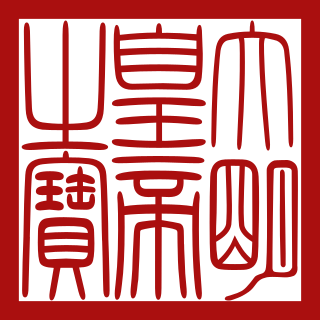
The Zhuang are a Tai-speaking ethnic group who mostly live in the Guangxi Zhuang Autonomous Region in Southern China. Some also live in the Yunnan, Guangdong, Guizhou, and Hunan provinces. They form one of the 56 ethnic groups officially recognized by the People's Republic of China. With the Bouyei, Nùng, Tày, and other Northern Tai speakers, they are sometimes known as the Rau or Rao people. Their population, estimated at 18 million people, makes them the largest minority in China, followed by the Hui and Manchu.

The Zhuang languages are any of more than a dozen Tai languages spoken by the Zhuang people of Southern China in the province of Guangxi and adjacent parts of Yunnan and Guangdong. The Zhuang languages do not form a monophyletic linguistic unit, as northern and southern Zhuang languages are more closely related to other Tai languages than to each other. Northern Zhuang languages form a dialect continuum with Northern Tai varieties across the provincial border in Guizhou, which are designated as Bouyei, whereas Southern Zhuang languages form another dialect continuum with Central Tai varieties such as Nung, Tay and Caolan in Vietnam. Standard Zhuang is based on the Northern Zhuang dialect of Wuming.

Yìquán, also known as Dàchéngquán, is a Chinese martial art founded by the Xìngyìquán master Wáng Xiāngzhāi (王薌齋). "Yì" (意) means Intent, "quán" (拳) means boxing.

The People's Republic of China competed at the 1988 Summer Olympics in Seoul, South Korea. 273 competitors, 149 men and 124 women, took part in 150 events in 25 sports.

The People's Republic of China competed at the 1992 Summer Olympics in Barcelona, Spain. 244 competitors, 117 men and 127 women, took part in 144 events in 23 sports.

Zhàn zhuāng is a training method often practiced by students of neijia, such as, Xing Yi Quan, Bagua Zhang and Taiji Quan. Zhàn zhuāng is sometimes translated Standing-on-stake, Standing Qigong, Standing Like a Tree, Post-standing, Pile-standing, or Pylon Standing. It is commonly called a form of Qigong, despite the differences from other Qigong methods in Zhàn zhuāng's orientation.

Zhuang Zedong was a Chinese table tennis player, three-time world men's singles champion and champion at numerous other table tennis events and a well-known political personality during the tumult of the Cultural Revolution. His chance meeting with American table tennis player, Glenn Cowan, during the 31st World Table Tennis Championship, later referred to as ping-pong diplomacy, triggered the first thawing of the ice in Sino-American relations since 1949. Zhuang was once married to the pianist Bao Huiqiao, and his second wife was the Chinese-born Japanese Atsuko Sasaki (佐々木敦子).

Ussuriana is an east Palearctic genus of butterfly in the family Lycaenidae.
Alloasteropetes is a genus of moths of the family Noctuidae. The genus was erected by Yasunori Kishida and Yoshiyuki Machijima in 1994.
Sinarella is a genus of moths of the family Erebidae. The genus was erected by Felix Bryk in 1949.
Xiaowei Zhuang is a Chinese-American biophysicist who is the David B. Arnold Jr. Professor of Science, Professor of Chemistry and Chemical Biology, and Professor of Physics at Harvard University, and an Investigator at the Howard Hughes Medical Institute. She is best known for her work in the development of Stochastic Optical Reconstruction Microscopy (STORM), a super-resolution fluorescence microscopy method, and the discoveries of novel cellular structures using STORM. She received a 2019 Breakthrough Prize in Life Sciences for developing super-resolution imaging techniques that get past the diffraction limits of traditional light microscopes, allowing scientists to visualize small structures within living cells. She was elected a Member of the American Philosophical Society in 2019 and was awarded a Vilcek Foundation Prize in Biomedical Science in 2020.
The Chadong language is a Kam–Sui language spoken mainly in Chadong Township, Lingui County, Guilin, northeastern Guangxi, China. It is most closely related to the Maonan language. Chadong has only been recently described by Chinese linguist Jinfang Li in the 1990s and 2000s.
Neopseustis moxiensis is a species of moth belonging to the family Neopseustidae. It was described by Liusheng Chen, Mamoru Owada, Min Wang, and Yang Long in 2009. It is known from the Sichuan Province in China.
Neopseustis fanjingshana is a species of moth belonging to the family Neopseustidae. It was described by Yang in 1988. It is known from the Guizhou Province and Hunan Province in China.

The House of Zhu was the ruling house of the Ming dynasty (1368–1644) and the Southern Ming (1644–1662) in Chinese history.

Neochalcosia is a genus of moths of the family Zygaenidae.
Hiroshia is a genus of moths belonging to the subfamily Thyatirinae of the Drepanidae.
Hiroshia nanlingana is a moth in the family Drepanidae. It is found in China.
Toxoides is a genus of moths belonging to the subfamily Thyatirinae of the Drepanidae.








